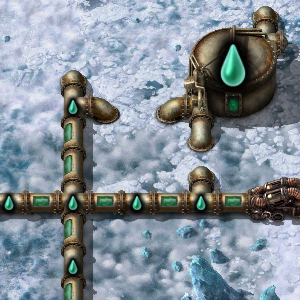Fluoroketone (cold): Difference between revisions
Jump to navigation
Jump to search
Created stub. |
No edit summary |
||
| Line 4: | Line 4: | ||
{{About/Space age}} | {{About/Space age}} | ||
'''Fluoroketone (cold)''' is the lower temperature variant of fluoroketone that is cooled in a [[cryogenic plant]]{{SA}} from [[fluoroketone (hot)]]{{SA}}. The cold fluoroketone can be used in an industrial process. Most processes that use this coolant (excluding fusion) generally produce half as much hot fluoroketone as cold fluoroketone they consume. | '''Fluoroketone (cold)''' is the lower temperature variant of fluoroketone that is cooled in a [[cryogenic plant]]{{SA}} from [[fluoroketone (hot)]]{{SA}}. The cold fluoroketone can be used in an industrial process. Most processes that use this coolant (excluding fusion) generally produce half as much hot fluoroketone as cold fluoroketone they consume. | ||
Cold fluoroketone, alongside [[fusion power cell]]s, can be used to create [[plasma]], an extremely ionized and ultra-high temperature [[Fluid system|fluid]] that can create 50 MW [[Electric system|electricity]]. | |||
== History == | == History == | ||
Revision as of 21:11, 3 November 2024
| Fluoroketone (cold) |
|
Recipe |
|
| + → | |
|
Total raw |
|
| + | |
|
Prototype type |
|
|
Internal name |
fluoroketone-cold |
|
Required technologies |
|
|
Produced by |
|
|
Consumed by |
|
| This article is a stub, and not comprehensive. |
|---|
| You can help this wiki by expanding it. |
![]() Space Age expansion exclusive feature.
Space Age expansion exclusive feature.
Fluoroketone (cold) is the lower temperature variant of fluoroketone that is cooled in a cryogenic plant![]() from fluoroketone (hot)
from fluoroketone (hot)![]() . The cold fluoroketone can be used in an industrial process. Most processes that use this coolant (excluding fusion) generally produce half as much hot fluoroketone as cold fluoroketone they consume.
. The cold fluoroketone can be used in an industrial process. Most processes that use this coolant (excluding fusion) generally produce half as much hot fluoroketone as cold fluoroketone they consume.
Cold fluoroketone, alongside fusion power cells, can be used to create plasma, an extremely ionized and ultra-high temperature fluid that can create 50 MW electricity.
